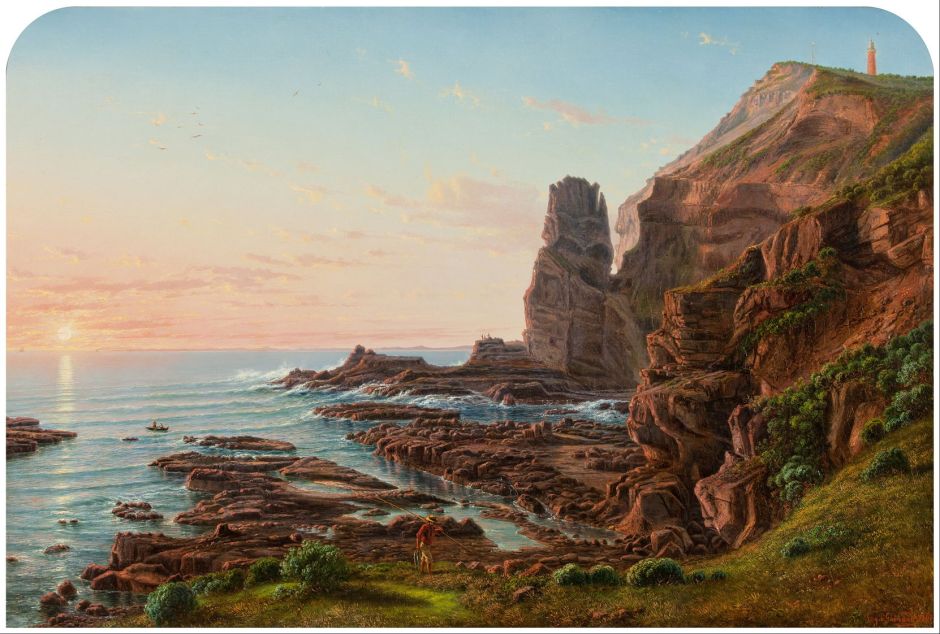By the early 1860s, the former gold prospector Eugene von Guérard (1811-1901) was making quite a name for himself and his highly detailed landscape paintings of Australia. He started to change direction, switching from Claudean sunsets to awe-inspiring mountains. His working methods apparently remained the same: like JMW Turner and earlier landscape painters, he made extensive sketches in graphite in front of his motif, then returned to the studio to turn them into a finished oil painting.

Painted in 1863, his North-east View from the Northern Top of Mount Kosciusko is one of the earliest of these works of the Burkean sublime. Mount Kosciuszko, as it’s now spelt, is mainland Australia’s highest mountain, at 2,228 metres (7,310 feet). It’s now in its own national park, inland of the south-east coast. It was first ascended by Europeans in 1840, but for some years was mapped in the wrong location. It took until 1940 to resolve that error.
Von Guérard travelled to Mount Kosciuszko in late 1862 in company with the German polar explorer and meteorologist Georg von Neumayer (1826-1909), where he made sketches and studies before returning to his studio just before Christmas.

Yalla-y-Poora from 1864 shows a palatial pastoral station in Victoria’s Western District then owned by John Ware, who had its well-watered valley planted with a mixture of native and British tree species. The peak in the far distance is Mount Challicum. This was one of von Guérard’s last commissioned paintings of a homestead, as the fashion for these waned. He made his studies for this painting during a visit in May 1864. Ware’s country mansion had only recently been built using bluestone, but suffered severely from rising damp and had to be replaced in 1905.

Castle Rock, Cape Schanck, which von Guérard painted in 1865, is a narrow spit of rugged land at the southern tip of the Mornington Peninsula. This separates the rough ocean of Bass Strait, seen here, from the sheltered Western Port. Its lighthouse, shown on the top of the cliffs at the right, was built in 1859. The prominent sea stack, which the title calls Castle Rock, is now better known as Pulpit Rock. The artist never abandoned his early influence by Claude Lorrain, which shines through in this dusk into-the-light view with its warm cliffs.

He also painted Tea Trees near Cape Schanck, Victoria (1865), which shows some wonderfully contorted trees further inland on the Mornington Peninsula. Tea trees, of the genus Melaleuca, are native to this part of Australia, and the source of oil now in great demand for skin products. It wasn’t exploited commercially until the 1920s, when an Australian chemist started to cultivate trees for their oil, which he considered had antiseptic properties.

That same year, he painted this elevated view of Sydney Heads (1865), the series of headlands which line and form the entrance to Sydney Harbour, and are now part of its national park.

Von Guérard still returned to the warm sunsets of Claude Lorrain, shown in his Sunset in New South Wales from 1865.

Around 1866, he seems to have returned to paint a distant view of Mount Kosciusko, Seen from the Victorian Border (Mount Hope Ranges).
In 1870, von Guérard was appointed the first Master of the School of Painting at the National Gallery of Victoria, where he taught for the next eleven years.

There remains uncertainty as to exactly whence von Guérard painted this view of the Dandenong Ranges from “Beleura” (1870); these low mountains are inland of the Mornington Peninsula, to the east of Melbourne.

Govett’s Leap and Grose River Valley, Blue Mountains, New South Wales (1873) shows this spectacular bridal veil waterfall, sometimes known as the Bridal Veil Falls, near Blackheath in the Blue Mountains. This is close to the outskirts of modern Sydney. Govett was the surveyor who discovered these falls in about 1831. With a drop of about 180 metres (just under 600 feet), this is now a popular spot for visitors.
Between about 1877-79, von Guérard travelled even further afield, visiting the islands of Tasmania and New Zealand.

In 1877, he painted this isolated Waterfall on the Clyde River, Tasmania, which is in the central uplands of the island.

By the late 1870s, von Guérard was increasingly being criticised for retaining the same style and fine detail in his landscapes. However, this view of Lake Wakatipu with Mount Earnslaw, Middle Island, New Zealand, painted in the studio between 1877-79, is a timeless masterpiece. This mountain, also known by its original name of Pikirakatahi, is 2,819 metres (9,000 feet) high, and wasn’t climbed until 1890.
In 1881, when he reached the age of seventy, he retired from his role at the School of Painting. Early the following year he and his wife left Australia to live in England. He seems to have invested much of the earnings from his paintings in Australian banks, and in 1893, when several of them crashed and the economy entered a depression, von Guérard’s income collapsed with them. He died in poverty in London in 1901.
Von Guérard was a painter of superb landscapes who played a major role in recording Australia, its scenery and wildlife. That he did this in a style from the early nineteenth century shouldn’t diminish his art in the slightest, and has enabled his paintings to be used as faithful visual references.

